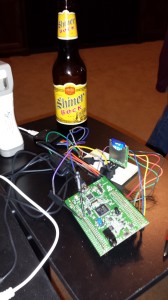The AVC Proof of Concept deadline is today. (Or maybe it was yesterday.) This is my lame attempt at desperately hoping to still qualify for the contest.
You see, the circuit boards that I ordered from Dirty Boards on the 3rd of May still haven't arrived. Without circuit boards in hand, I really don't have much to show for my AVC entry.
On the off chance that the AVC staff will take mercy on me and allow me to remain in the contestant pool, my robot consists of:
- A Turnigy 1/16 Mini Rally Extreme R/C chassis
- A custom circuit board with an STM32F405 microcontroller
- An Adafruit "Ultimate GPS" module running custom firmware
- A Maxim MAX21000 ultra-accurate 3-axis gyroscope
- An ATTINY88 acting as an integrated R/C override mux
- An ST LSM9Ds0 9DOF inertial measurement chip
- A Microchip (formerly SMC) PAC1710 current sense chip
- A Micro-SD card slot for data logging
Yeah, without pics, I realize the credibility in this post is near zero. But that's all I have right now- words and ideas. I'm well aware that the chances of me being ready in time are pretty slim, but I'm hoping the decision on whether or not to drop out can be my decision and not the decision of the AVC staff.
So I'll send them a link to this post and see what they say...
